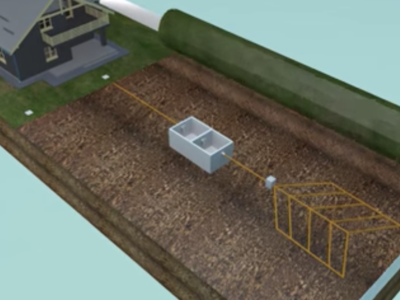Expert Guide
How septic tanks work
If your property has a septic tank, it’s important to know how it works. If you understand more about how it works, it can make it easier to know what you need to do to look after it, and how to spot a problem.
Of course, with a septic tank being out of sight underground, it can be difficult to know what’s going on - so this guide will talk you through how it works, and what you need to bear in mind to get the most from your septic tank.
The different types of septic tank
A septic tank will take the wastewater from your property’s toilets, sinks, baths and showers, dishwashers and washing machines.
The waste water leaves your property through the drainage pipes to your septic tank, and will usually pass through a number of inspection chambers or manholes.
There are a number of different types of septic tanks, but the most common types are constructed of brick or Glass Reinforced Plastic (GRP).
Brick-built septic tanks
Brick-built septic tanks and are typically comprised of two chambers. Once the waste water reaches the level of the outlet pipe in the first chamber, it will overflow into the second chamber.
Within the septic tank are dip pipes or T-pipes (depending upon the age of the tank) which are attached to the inlet and outlet pipes of the tank. The dip pipes play a crucial role in retaining the solids from the wastewater within the tank, and preventing them entering into the drainage field.
A septic tank does not provide any treatment of the waste water, instead the solids in the water break down and separate into 3 distinct zones or layers:
- The top layer is made up of less dense matter – fats, oils and solids that have not yet broken down, also known as the crust.
- The second layer is mostly wastewater without any solids remaining, and it is this water which passes out of the septic tank and into the soakaway system.
- The bottom layer is known as sludge, and consists largely of more dense waste that builds up slowly over time. This and the top layer of crust is what must be removed during a routine septic tank emptying.
This separation process will repeat itself depending on how many chambers your septic tank has. The liquid leaves the tank and makes its way into the soakaway system, where it should safely percolate.
Glass Reinforced Plastic (GRP) septic tanks
GRP septic tanks work in much the same way as brick-built tanks, although they are designed differently. In the same way as a brick-built tank, a GRP tank does not provide treatment of the wastewater, instead it allows it to separate into the same distinct layers. Whereas within a brick-built septic tank, the dip pipes (or T-pipes) prevent solid waste particles from leaving the tank, in a GRP septic tank this role is performed by a baffle.
The purpose of a soakaway or drainage field
A septic tank doesn’t work in isolation. In order to perform its function, it must connect to a drainage field or soakaway system.
A drainage field is a network of pipes which follow on from a septic tank or sewage treatment plant. A soakaway system can be a rubble pit or deep bore soakaway - but please be aware that these types of soakaways are no longer compliant with current regulations, which set down that a septic tank must discharge to a drainage field.
You can find out more about septic tank regulations in our guide here.
The purpose of a drainage field is to allow the liquid waste that has left the septic tank to percolate through the soils surrounding the pipework, and the pipework is typically perforated or slotted to enable this to happen.
The process of the liquid waste percolating through the particles in the soil provides a form of treatment of the waste, and it can then safely disperse into the surrounding sub soils.
How to keep your septic tank working
Septic tanks and the soakaway systems they connect to won’t last a lifetime, but with a bit of care and attention you can make sure that you get as many years of trouble free drainage for your property as possible.
Following these simple tips would be a good place to start:
Be careful what you flush down the loo or put down the sink
The waste water entering your septic tank should only include waste from your property’s toilets, showers, sinks and kitchen appliances. You should never allow the following to pass into a septic tank by flushing down toilets, as they are likely to quickly cause problems:
- Sanitary products
- Disposable nappies
- Face wipes
Similarly, you should be very careful with what you pour down the sink, in particular:
- Fats or cooking oil should be disposed of separately and never poured down the sink - this in particular can cause soakaway problems as it can prevent the soil surrounding your soakaway system from being able to absorb the waste water effectively
- Anti-bacterial products such as kitchen cleaners and handwashes should be avoided as they can kill off the `good’ bacteria in your septic tank which helps with the separation of the waste water within it. There are some septic tank friendly cleaning product ranges, such as Ecover, which can help to avoid this problem.
Get your septic tank emptied regularly
Ensuring that your septic tank is emptied regularly is important in ensuring that it can work properly. A tanker will attend your property and will remove the solids and waste water from your tank.
How often you will need this to happen depends on a number of different factors, but in general most septic tanks need to be emptied annually. If you’re not sure, just ask a local tanker company to give you advice.
Keep your eye out for any septic tank problems
The company that empties your septic tank should let you know if they spot any problems with the drainage system. Don’t just put this to the back of your mind, which of course is tempting to do if it’s not started to affect you yet. There may also be other signs of trouble with your drainage system, such as:
- dirty water pooling above the ground where your septic tank or soakaway system is
- your toilets flushing slowly or overflowing
- your septic tank filling up more quickly and needing to be emptied more frequently than usual
If you notice anything unusual with your septic tank, it is best to get it checked out as soon as possible - this is because problems underground can worsen over time if left unchecked.
The team at UKDP can offer you expert advice and guidance on any septic tank or soakaway problems, so call us today on 01628 788600 or contact us.

Got some questions?
We are a friendly team of specialists with decades of combined experience. We're here to help.

Got some questions?
We are a friendly team of specialists with decades of combined experience. We're here to help.



